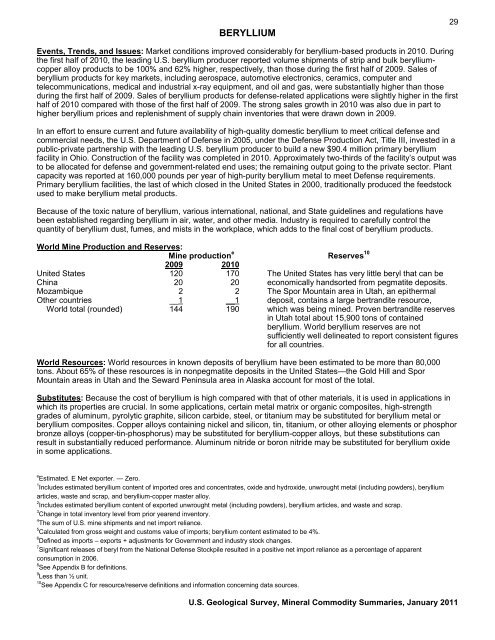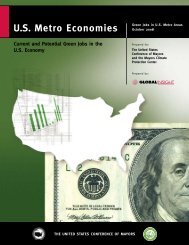BERYLLIUM29Events, Trends, <strong>and</strong> Issues: Market conditions improved considerably for beryllium-based products in 2010. Duringthe first half of 2010, the leading U.S. beryllium producer reported volume shipments of strip <strong>and</strong> bulk berylliumcopperalloy products to be 100% <strong>and</strong> 62% higher, respectively, than those during the first half of 2009. Sales ofberyllium products for key markets, including aerospace, automotive electronics, ceramics, computer <strong>and</strong>telecommunications, medical <strong>and</strong> industrial x-ray equipment, <strong>and</strong> oil <strong>and</strong> gas, were substantially higher than thoseduring the first half of 2009. Sales of beryllium products for defense-related applications were slightly higher in the firsthalf of 2010 compared with those of the first half of 2009. The strong sales growth in 2010 was also due in part tohigher beryllium prices <strong>and</strong> replenishment of supply chain inventories that were drawn down in 2009.In an effort to ensure current <strong>and</strong> future availability of high-quality domestic beryllium to meet critical defense <strong>and</strong>commercial needs, the U.S. Department of Defense in 2005, under the Defense Production Act, Title III, invested in apublic-private partnership with the leading U.S. beryllium producer to build a new $90.4 million primary berylliumfacility in Ohio. Construction of the facility was completed in 2010. Approximately two-thirds of the facility’s output wasto be allocated for defense <strong>and</strong> government-related end uses; the remaining output going to the private sector. Plantcapacity was reported at 160,000 pounds per year of high-purity beryllium metal to meet Defense requirements.Primary beryllium facilities, the last of which closed in the United States in 2000, traditionally produced the feedstockused to make beryllium metal products.Because of the toxic nature of beryllium, various international, national, <strong>and</strong> State guidelines <strong>and</strong> regulations havebeen established regarding beryllium in air, water, <strong>and</strong> other media. Industry is required to carefully control thequantity of beryllium dust, fumes, <strong>and</strong> mists in the workplace, which adds to the final cost of beryllium products.World Mine Production <strong>and</strong> Reserves:Mine production e Reserves 102009 2010United States 120 170 The United States has very little beryl that can beChina 20 20 economically h<strong>and</strong>sorted from pegmatite deposits.Mozambique 2 2 The Spor Mountain area in Utah, an epithermalOther countries __1 __1 deposit, contains a large bertr<strong>and</strong>ite resource,World total (rounded) 144 190 which was being mined. Proven bertr<strong>and</strong>ite reservesin Utah total about 15,900 tons of containedberyllium. World beryllium reserves are notsufficiently well delineated to report consistent figuresfor all countries.World Resources: World resources in known deposits of beryllium have been estimated to be more than 80,000tons. About 65% of these resources is in nonpegmatite deposits in the United States—the Gold Hill <strong>and</strong> SporMountain areas in Utah <strong>and</strong> the Seward Peninsula area in Alaska account for most of the total.Substitutes: Because the cost of beryllium is high compared with that of other materials, it is used in applications inwhich its properties are crucial. In some applications, certain metal matrix or organic composites, high-strengthgrades of aluminum, pyrolytic graphite, silicon carbide, steel, or titanium may be substituted for beryllium metal orberyllium composites. Copper alloys containing nickel <strong>and</strong> silicon, tin, titanium, or other alloying elements or phosphorbronze alloys (copper-tin-phosphorus) may be substituted for beryllium-copper alloys, but these substitutions canresult in substantially reduced performance. Aluminum nitride or boron nitride may be substituted for beryllium oxidein some applications.e Estimated. E Net exporter. — Zero.1 Includes estimated beryllium content of imported ores <strong>and</strong> concentrates, oxide <strong>and</strong> hydroxide, unwrought metal (including powders), berylliumarticles, waste <strong>and</strong> scrap, <strong>and</strong> beryllium-copper master alloy.2 Includes estimated beryllium content of exported unwrought metal (including powders), beryllium articles, <strong>and</strong> waste <strong>and</strong> scrap.3 Change in total inventory level from prior yearend inventory.4 The sum of U.S. mine shipments <strong>and</strong> net import reliance.5 Calculated from gross weight <strong>and</strong> customs value of imports; beryllium content estimated to be 4%.6 Defined as imports – exports + adjustments for Government <strong>and</strong> industry stock changes.7 Significant releases of beryl from the National Defense Stockpile resulted in a positive net import reliance as a percentage of apparentconsumption in 2006.8 See Appendix B for definitions.9 Less than ½ unit.10 See Appendix C for resource/reserve definitions <strong>and</strong> information concerning data sources.U.S. Geological Survey, <strong>Mineral</strong> <strong>Commodity</strong> <strong>Summaries</strong>, January <strong>2011</strong>
30BISMUTH(Data in metric tons of bismuth content unless otherwise noted)Domestic Production <strong>and</strong> Use: The United States ceased production of primary refined bismuth in 1997 <strong>and</strong> is thushighly import dependent for its supply. A small amount of bismuth is recycled by some domestic firms. Bismuth iscontained in some lead ores mined domestically, but the bismuth-containing residues are not processed domestically<strong>and</strong> may be exported. The value of reported consumption of bismuth was approximately $19 million. About 60% ofthe bismuth was used in pharmaceuticals <strong>and</strong> chemicals, 36% in metallurgical additives, <strong>and</strong> 4% in fusible alloys,solders, <strong>and</strong> ammunition cartridges.The Safe Drinking Water Act Amendment of 1996 required that all new <strong>and</strong> repaired fixtures <strong>and</strong> pipes for potablewater supply be lead free after August 1998. As a result, that opened a wider market for bismuth as a metallurgicaladditive to lead-free pipes. Bismuth use in water meters <strong>and</strong> fixtures is one particular application that has increased inrecent years. An application with major growth potential is the use of zinc-bismuth alloys to achieve thinner <strong>and</strong> moreuniform galvanization. Bismuth was also used domestically in the manufacture of ceramic glazes, crystal ware, <strong>and</strong>pigments; as an additive to free-machining steels; <strong>and</strong> as an additive to malleable iron castings.Salient Statistics—United States: 2006 2007 2008 2009 2010 eProduction:Refinery — — — — ––Secondary (old scrap) 80 100 100 60 50Imports for consumption, metal 2,300 3,070 1,930 1,250 1,200Exports, metal, alloys, <strong>and</strong> scrap 311 421 375 397 350Consumption:Reported 1,960 2,630 1,090 1,180 1,050Apparent 2,120 2,740 1,560 1,010 910Price, average, domestic dealer, dollars per pound 5.04 14.07 12.73 7.84 8.22Stocks, yearend, consumer 120 139 228 134 125Net import reliance 1 as a percentage ofapparent consumption 96 96 94 94 94Recycling: All types of bismuth-containing new <strong>and</strong> old alloy scrap were recycled <strong>and</strong> contributed about 10% of U.S.bismuth consumption, or 100 tons.Import Sources (2006–09): Belgium, 33%; China, 31%; United Kingdom, 17%; Mexico, 11%; <strong>and</strong> other, 8%.Tariff: Item Number Normal Trade Relations12-31-10Bismuth <strong>and</strong> articles thereof, including waste<strong>and</strong> scrap 8106.00.0000 Free.Depletion Allowance: 22% (Domestic), 14% (Foreign).Government Stockpile: None.Prepared by James F. Carlin, Jr. [(703) 648-4985, jcarlin@usgs.gov, fax: (703) 648-7757]
- Page 3: U.S. Department of the InteriorKEN
- Page 6 and 7: INTRODUCTION3Each chapter of the 20
- Page 8 and 9: 5NET EXPORTS OF MINERALRAW MATERIAL
- Page 10 and 11: SIGNIFICANT EVENTS, TRENDS, AND ISS
- Page 12 and 13: mineral materials valued at $1.30 b
- Page 14 and 15: 11MAJOR METAL-PRODUCING AREASAuB2P1
- Page 16 and 17: 13MAJOR INDUSTRIAL MINERAL-PRODUCIN
- Page 18 and 19: ABRASIVES (MANUFACTURED)15Events, T
- Page 20 and 21: ALUMINUM17The United States continu
- Page 22 and 23: ANTIMONY19Events, Trends, and Issue
- Page 24 and 25: ARSENIC21According to university me
- Page 26 and 27: ASBESTOS23Events, Trends, and Issue
- Page 28 and 29: BARITE25Nationally, the rig count o
- Page 30 and 31: BAUXITE AND ALUMINA27Events, Trends
- Page 34 and 35: BISMUTH31Events, Trends, and Issues
- Page 36 and 37: BORON33Events, Trends, and Issues:
- Page 38 and 39: BROMINE35Events, Trends, and Issues
- Page 40 and 41: CADMIUM37NiCd battery use in consum
- Page 42 and 43: CEMENT39The manufacture of clinker
- Page 44 and 45: CESIUM41Events, Trends, and Issues:
- Page 46 and 47: CHROMIUM43Stockpile Status—9-30-1
- Page 48 and 49: CLAYS45Tariff: Item Number Normal T
- Page 50 and 51: COBALT47Events, Trends, and Issues:
- Page 52 and 53: COPPER49Events, Trends, and Issues:
- Page 54 and 55: DIAMOND (INDUSTRIAL)51Events, Trend
- Page 56 and 57: DIATOMITE53Events, Trends, and Issu
- Page 58 and 59: FELDSPAR55Feldspar use in tile and
- Page 60 and 61: FLUORSPAR57with planned output of 1
- Page 62 and 63: GALLIUM59In response to the unprece
- Page 64 and 65: GARNET (INDUSTRIAL)61Events, Trends
- Page 66 and 67: GEMSTONES63Events, Trends, and Issu
- Page 68 and 69: GERMANIUM65Events, Trends, and Issu
- Page 70 and 71: GOLD67With the increase in price of
- Page 72 and 73: GRAPHITE (NATURAL)69Events, Trends,
- Page 74 and 75: GYPSUM71Through 2010, more than 3,6
- Page 76 and 77: HELIUM73Events, Trends, and Issues:
- Page 78 and 79: INDIUM75China’s 21 indium produce
- Page 80 and 81: IODINE77Events, Trends, and Issues:
- Page 82 and 83:
IRON AND STEEL79Events, Trends, and
- Page 84 and 85:
IRON AND STEEL SCRAP81Tariff: Item
- Page 86 and 87:
IRON AND STEEL SLAG83Events, Trends
- Page 88 and 89:
IRON ORE85In 2009, China imported a
- Page 90 and 91:
IRON OXIDE PIGMENTS87Events, Trends
- Page 92 and 93:
KYANITE AND RELATED MATERIALS89Even
- Page 94 and 95:
LEAD91caused by underground fires a
- Page 96 and 97:
LIME93The lime industry is facing p
- Page 98 and 99:
LITHIUM95market, and a facility at
- Page 100 and 101:
MAGNESIUM COMPOUNDS97In Australia,
- Page 102 and 103:
MAGNESIUM METAL99U.S. magnesium con
- Page 104 and 105:
MANGANESE101Government Stockpile:St
- Page 106 and 107:
MERCURY103Events, Trends, and Issue
- Page 108 and 109:
MICA (NATURAL)105Depletion Allowanc
- Page 110 and 111:
MOLYBDENUM107Events, Trends, and Is
- Page 112 and 113:
NICKEL109Nickel prices were adverse
- Page 114 and 115:
NIOBIUM (COLUMBIUM)111Events, Trend
- Page 116 and 117:
NITROGEN (FIXED)—AMMONIA113Accord
- Page 118 and 119:
PEAT115Events, Trends, and Issues:
- Page 120 and 121:
PERLITE117Events, Trends, and Issue
- Page 122 and 123:
PHOSPHATE ROCK119Events, Trends, an
- Page 124 and 125:
PLATINUM-GROUP METALS121Events, Tre
- Page 126 and 127:
POTASH123Events, Trends, and Issues
- Page 128 and 129:
PUMICE AND PUMICITE125Events, Trend
- Page 130 and 131:
QUARTZ CRYSTAL (INDUSTRIAL)127Event
- Page 132 and 133:
RARE EARTHS129Events, Trends, and I
- Page 134 and 135:
RHENIUM131Events, Trends, and Issue
- Page 136 and 137:
RUBIDIUM133Events, Trends, and Issu
- Page 138 and 139:
SALT135Many chefs have advocated us
- Page 140 and 141:
SAND AND GRAVEL (CONSTRUCTION)137Ev
- Page 142 and 143:
SAND AND GRAVEL (INDUSTRIAL)139The
- Page 144 and 145:
SCANDIUM141Scandium’s use in meta
- Page 146 and 147:
SELENIUM143Events, Trends, and Issu
- Page 148 and 149:
SILICON145Events, Trends, and Issue
- Page 150 and 151:
SILVER147Silver was used as a repla
- Page 152 and 153:
SODA ASH149A Wyoming soda ash produ
- Page 154 and 155:
SODIUM SULFATE151Events, Trends, an
- Page 156 and 157:
STONE (CRUSHED)153Events, Trends, a
- Page 158 and 159:
STONE (DIMENSION)155Events, Trends,
- Page 160 and 161:
STRONTIUM157Events, Trends, and Iss
- Page 162 and 163:
SULFUR159World sulfur production in
- Page 164 and 165:
TALC AND PYROPHYLLITE161Events, Tre
- Page 166 and 167:
TANTALUM163Events, Trends, and Issu
- Page 168 and 169:
TELLURIUM165Events, Trends, and Iss
- Page 170:
THALLIUM167Beginning in 2009, there
- Page 173 and 174:
170TIN(Data in metric tons of tin c
- Page 175 and 176:
172TITANIUM AND TITANIUM DIOXIDE 1(
- Page 177 and 178:
174TITANIUM MINERAL CONCENTRATES 1(
- Page 179 and 180:
176TUNGSTEN(Data in metric tons of
- Page 181 and 182:
178VANADIUM(Data in metric tons of
- Page 183 and 184:
180VERMICULITE(Data in thousand met
- Page 185 and 186:
182WOLLASTONITE(Data in metric tons
- Page 187 and 188:
184YTTRIUM 1(Data in metric tons of
- Page 189 and 190:
186ZEOLITES (NATURAL)(Data in metri
- Page 191 and 192:
188ZINC(Data in thousand metric ton
- Page 193 and 194:
190ZIRCONIUM AND HAFNIUM(Data in me
- Page 195 and 196:
192APPENDIX AAbbreviations and Unit
- Page 197 and 198:
194Demonstrated.—A term for the s
- Page 199 and 200:
196Part B—Sources of Reserves Dat
- Page 201:
198Europe and Central Eurasia—con







